Related Research Articles
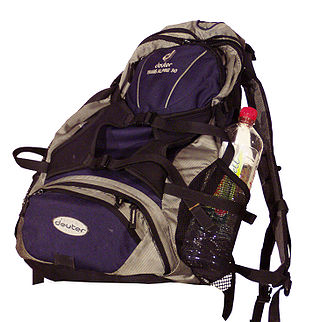
A backpack—also called knapsack, schoolbag,rucksack, rucksac, pack, sackpack, booksack, bookbag or backsack—is, in its simplest frameless form, a fabric sack carried on one's back and secured with two straps that go over the shoulders, but it can have an external frame, internal frame, and there are bodypacks.

Webbing is a strong fabric woven as a flat strip or tube of varying width and fibres, often used in place of rope. It is a versatile component used in climbing, slacklining, furniture manufacturing, automobile safety, auto racing, towing, parachuting, military apparel, load securing, and many other fields.

MOLLE is an acronym for Modular Lightweight Load-carrying Equipment. It is used to define the current generation of load-bearing equipment and backpacks used by a number of NATO armed forces, especially the British Army and the United States Army.
Jungle boots are a type of combat boot designed for use in jungle warfare or in hot, wet, and humid environments where a standard leather combat boot would be uncomfortable or unsuitable to wear. Jungle boots have vent holes in the instep and sometimes a canvas upper to aid in ventilation and drainage of moisture.

Personal Load Carrying Equipment (PLCE) is one of several tactical webbing systems of the British Armed Forces. Dependent upon the year of design, and the decade of introduction, the webbing system was named and is commonly referred to as the 85 Pattern, the 90 Pattern or the 95 Pattern webbing.

The M-1965 Field Jacket, eponymously named after the year it was introduced, is a popular field jacket initially designed for the United States Armed Forces under the MIL-C-43455J standard.
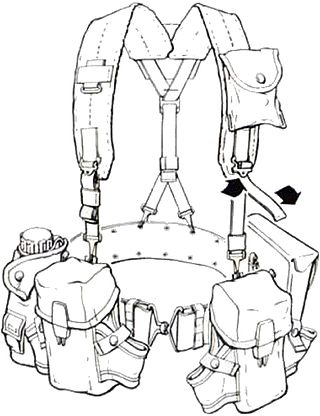
The All-Purpose Lightweight Individual Carrying Equipment (ALICE) is a set of load-carrying equipment adopted as United States Army Standard A on 17 January 1973 to replace the M-1956 Individual Load-Carrying Equipment (ILCE) and M-1967 Modernized Load-Carrying Equipment (MLCE). Although since superseded by MOLLE, ALICE gear is still in some limited use with the U.S. Army National Guard, State Guard, also some ground units of the Navy and Air Force.

The Modular Integrated Communications Helmet (MICH) is a U.S. combat helmet and one of several used by the U.S. military. It was developed by the United States Army Soldier Systems Center to be the next generation of protective combat helmets for use by the U.S. Army.

The Modernized Load-Carrying Equipment, also known as M-1967 Modernized Load-Carrying Equipment or MLCE, was introduced into United States Army service in 1968 during the Vietnam War. The M-1967 MLCE was not specifically designed to replace the canvas and cotton duck M-1956 Load-Carrying Equipment, but instead it was designed for use in tropical environments.

The IIFS was introduced in 1988, to serve as a fighting and existence carrying system - a possible replacement for the All-purpose Lightweight Individual Carrying Equipment employed and fielded by United States Armed Forces since 1973.
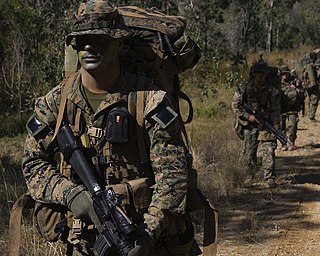
The Improved Load Bearing Equipment (ILBE) is a United States Marine Corps program that had included individual load carriage equipment, individual hydration systems and individual water purification.

Ultralight backpacking is a style of lightweight backpacking that emphasizes carrying the lightest and least amount of gear. While no technical standards exist, some hikers consider "ultralight" to mean an initial base weight of less than 4.5 kg (9.9 lb). Base weight is the weight of a fully loaded backpack at the start of a trip, excluding worn weight and consumables such as food, water, and fuel. Base weight can be lowered by reducing the weight of individual items of gear, or by choosing not to carry that gear. Ultralight backpacking is most popular among thru-hikers.
The McGuire Rig was used to extract soldiers from the jungles of Vietnam. It would be suspended from a helicopter and used to extract soldiers from areas without a suitable pick-up zone. It was simple, inexpensive, and effective. Although less comfortable than the STABO harness, it did not require the soldiers to carry any special equipment. It was designed by Sergeant Major Charles T. McGuire, a member of Project DELTA, a Special Forces reconnaissance project.
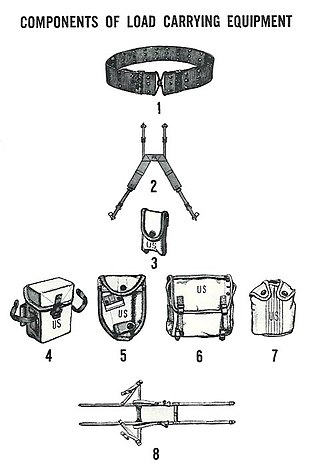
The M-1956 Load-Carrying Equipment (LCE), also known as the Individual Load-Carrying Equipment (ILCE), was developed by the U.S. Army and first issued in the early 1960s. The M-1956 LCE was designed to replace the M-1945 Combat Pack, the M-1923 cartridge belt, the M-1936 pistol belt and the M-1937 BAR magazine belt. The M-1956 LCE was designed to be quickly configured, using no tools, to accommodate various mission and ammunition loads. The M-1956 LCE remained in service through the 1980s and set the standard for future United States military load-carrying equipment.

A haversack, musette bag or small pack is a bag with a single shoulder strap. Although similar to a backpack, the single shoulder strap differentiates this type from other backpacks. There are exceptions to this general rule.

The Pouch Attachment Ladder System or PALS is a grid of webbing invented and patented by United States Army Natick Soldier Research, Development and Engineering Center used to attach smaller equipment onto load-bearing platforms, such as vests and backpacks. It was first used on MOLLE rucksacks, but is now found on a variety of tactical equipment, such as the U.S. Improved Outer Tactical Vest, Interceptor body armor, USMC Improved Load Bearing Equipment backpack and Modular Tactical Vest. It is used to attach items such as holsters, magazine pouches, radio pouches, knife sheathes, and other gear. A wide variety of pouches are commercially available, allowing soldiers to customize their kit. There is also a variety of attachment methods including the Alice Clip, the Natick snap, and soft, interwoven straps. The PALS system has begun to be adopted by other forces, such as the British Army, who use it on their Osprey body armor.
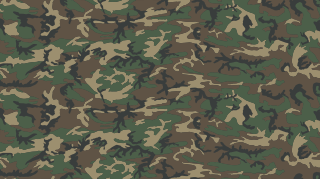
The ERDL pattern, also known as the Leaf pattern, is a camouflage pattern developed by the United States Army at its Engineer Research & Development Laboratories (ERDL) in 1948. It was not used until the Vietnam War, when it was issued to elite reconnaissance and special operations units beginning early 1967.

The OG-107 was the basic work utility uniform (fatigues) of all branches of the United States Armed Forces from 1952 until its discontinuation in 1989. The designation came from the U.S. Army's coloring code "Olive Green 107" and "Olive Green 507", which were shades of dark green, the OG-107 being cotton and OG-507 polyester-cotton blend introduced in the early 1970s. Regardless of the fabric, the two shades were almost identical. The OG-107 was superseded by the Battle Dress Uniform (BDU) throughout the 1980s, and was also used by several other countries, including ones that received military aid from the United States.
Family of Improved Load Bearing Equipment (FILBE) is a series of equipment used by the United States Marine Corps for personal load carrying. It comprises the backpack and various attachments carried by an individual Marine in the field. The FILBE was designed as an improvement over the prior ILBE system that was not compatible with the newest body armor systems.
References
- ↑ Metzger, Eldon (July 1975). History Of The Development Of The LINCLOE Load-Carrying Equipment (PDF). Natick, MA: U.S. Army Materiel Command. Archived from the original on September 13, 2014. Retrieved 2014-09-12.
- ↑ Training Circular TC 10-8, United States Army: The Lightweight Rucksack: Nylon OG106 (With Riveted Frame), September 1967